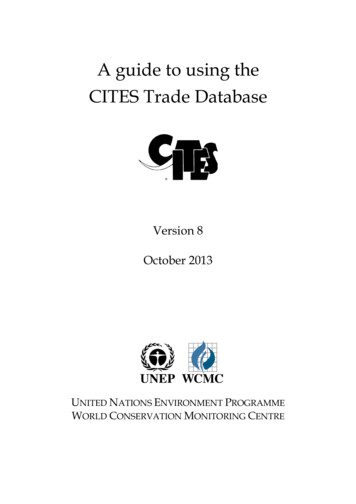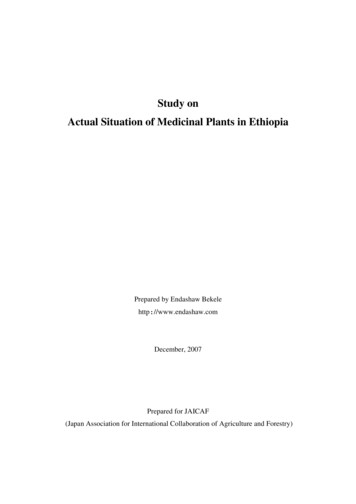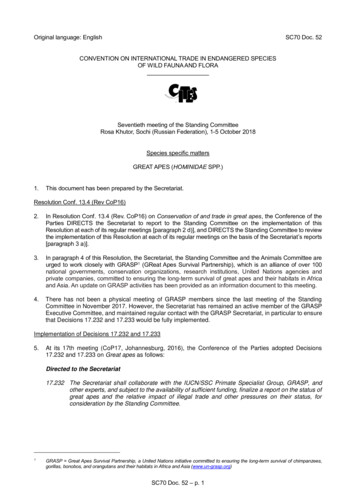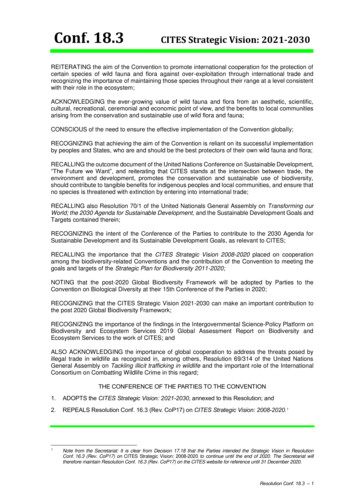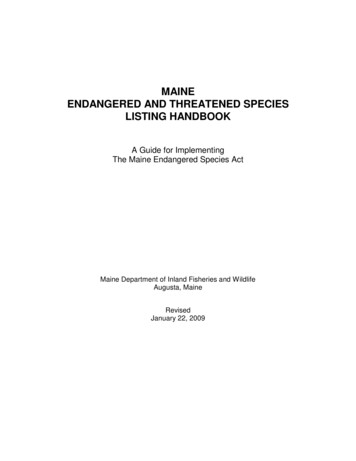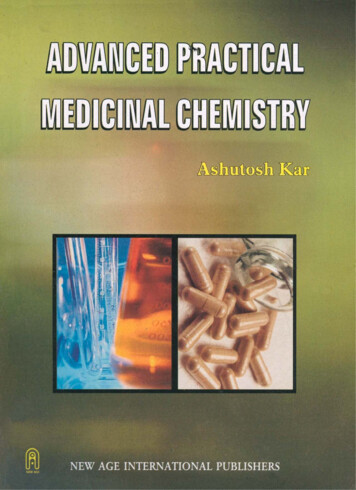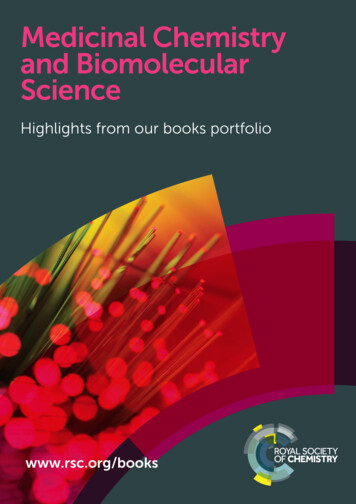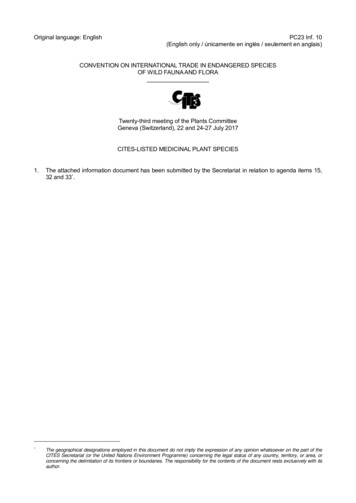
Transcription
Original language: EnglishPC23 Inf. 10(English only / únicamente en inglés / seulement en anglais)CONVENTION ON INTERNATIONAL TRADE IN ENDANGERED SPECIESOF WILD FAUNA AND FLORATwenty-third meeting of the Plants CommitteeGeneva (Switzerland), 22 and 24-27 July 2017CITES-LISTED MEDICINAL PLANT SPECIES1.The attached information document has been submitted by the Secretariat in relation to agenda items 15,32 and 33*.*The geographical designations employed in this document do not imply the expression of any opinion whatsoever on the part of theCITES Secretariat (or the United Nations Environment Programme) concerning the legal status of any country, territory, or area, orconcerning the delimitation of its frontiers or boundaries. The responsibility for the contents of the document rests exclusively with itsauthor.
CITES-listedmedicinal plantspecies20.07.2017
Contents1.Background . 32.A list of CITES-listed medicinal plant species . 83.E-commerce survey of CITES-listed medicinal plant species focused on eBay and amazon . 334.Analysis . 365.Recommendations . 37This documents has been prepared by Jin A Choi under contract with the CITES Secretariat.
1. BackgroundThe aim of this study is to make a list of medicinal plant species and take stock of e-commerce in those medicinal plants, with a particular focus on the useof annotations. As a background, the table below presents all Plants Committee documents related to medicinal plants (keyword search of ‘medicinal’,‘traditional medicine’, ‘herbal remedy’, and ‘aroma’)ResultPlant CommitteeTwenty-second meeting of the Plants CommitteeTbilisi (Georgia), 19-23 October 2015Twenty-first meeting of the Plants CommitteeVeracruz (Mexico), 02-08 May 2014Twentieth meeting of the Plants CommitteeDublin (Ireland), 22-30 March 2012CategoryDocumentAgenda and documentsPC22 Doc.22.1 Annex 1 - Quick scan of Orchidaceae species in European commerce ascomponents of cosmetic, food and medicinal com/pc/22/E-PC22-22-01%20Annex.pdfInformation documentsTotal documentsAgenda and documents1-Information documentsPC21 Inf. 11. Primer on Importing & Exporting CITES-Listed Species Used in the UnitedStates in Dietary Supplements, Traditional Herbal Medicines, and Homeopathic Products(submitted by the United States of com/pc/21/E-PC21-Inf-11.pdfTotal documents1Agenda and documentsPC20 Doc.15.1 Timber species, medicinal plants and agarwood-producing species(Decisions 15.26 and 15.27) – Report of the working /pc/20/E20-15-01.pdfInformation documentsPC20 Inf. 9. Questionnaire for the personal care products and herbal products industrieson finished products manufactured from orchids that are packaged and ready for retailtrade (submitted by the United States of on/com/pc/20/inf docs/E20-09i.pdfTotal documents2
Nineteenth meeting of the Plants CommitteeGeneva (Switzerland), 18-21 April 2011Agenda and documentsPC19 10.4 Timber species, medicinal plants and agarwood-producing species (Decisions15.26 and 15.27) – Progress reportNo documentInformation documentsTotal documents1(0)Agenda and documentsPC18 Doc.8.5 Progress report on seven Asian species of medicinal m/pc/18/E-PC18-08-05.pdfPC18 Doc.14.4 Medicinal m/pc/18/E-PC18-14-04.pdfInformation documentsPC18 Inf. 6. Trade survey study on succulent Euphorbia species protected by CITES andused as cosmetic, food and medicine, with special focus on Candelilla m/pc/18/X-PC18-Inf06.pdfTotal documents3Agenda and documents17.1 Timber species and medicinal plantsPC17 Doc.17.1.1 Overview on non-detriment findings for timber species and es/eng/com/pc/17/E-PC17-17-01-01.pdfPC17 Doc.17.1.2 Summary report on the non-detriment findings for ramin (Gonystylusspp.) for Malaysia in pc/17/E-PC17-17-01-02.pdfPC17 Doc.17.1.3 Final report on the study on abundance, distribution and conservationstatus of Guaiacum sanctum L. in m/pc/17/E-PC17-17-01-03.pdfInformation documentsPC17 Inf. 10. Review of the Status, Harvest, Trade and Management of Seven AsianCITES-listed Medicinal and Aromatic Plant n/com/pc/17/X-PC17-Inf-10.pdfTotal documents4Eighteenth meeting of the Plants CommitteeBuenos Aires (Argentina), 17-21 March 2009Seventeenth meeting of the Plants CommitteeGeneva (Switzerland), 15-19 April 2008
Agenda and documentsPC16 Doc.10.5 Asian medicinal om/pc/16/E-PC16-10-05.pdfPC16 Doc.17.1 Medicinal m/pc/16/E-PC16-17-01.pdfInformation documentsPC16 Inf. 9. International Standard for Sustainable Wild Collection of Medicinal andAromatic Plants mmon/com/pc/16/X-PC16-09-Inf.pdfTotal documents3Agenda and documentsPC15 Doc.10.2.2 Seven Asian medicinal om/pc/15/E-PC15-10-02-02.pdfPC15 Doc.17. Annotations for medicinal plants included in Appendix /15/E-PC15-17.pdfInformation documentsPC15 Inf. 8. Annotation #9 and the Guiding principles for annotations relating tomedicinal /com/pc/15/X-PC15-08-Inf.pdfPC15 Inf. 10. International standard for sustainable wild collection of medicinal andaromatic plants mmon/com/pc/15/X-PC15-10-Inf.pdfTotal documents4Agenda and documentsPC14 Doc.7.2 Definitions of the technical terms used in the annotations for medicinalplants [Decisions 12.23 and 11.118 (Rev. om/pc/14/E-PC14-07-02.pdfInformation documentsPC14 Inf. 3. Revision of the # Annotations for medicinal and aromatic plants included inthe CITES mmon/com/pc/14/X-PC14-03-Inf.pdfTotal documents2Sixteenth meeting of the Plants CommitteeLima (Peru), 03-08 July 2006Fifteenth meeting of the Plants CommitteeGeneva (Switzerland), 17-21 May 2005Fourteenth meeting of the Plants CommitteeWindhoek (Namibia), 16-20 February 2004
Thirteenth meeting of the Plants CommitteeGeneva (Switzerland), 12-15 August 2003Twelfth meeting of the Plants CommitteeLeiden (Netherlands), 13-17 May 2002Agenda and documentsPC13 10.1 Definitions of the technical terms used in the annotations of medicinal plants[Decisions 12.23 and 11.118 (Rev.CoP12)]No documentPC 13 15.3 Checklist of medicinal and aromatic plants, new editionNo documentInformation documentsTotal documents2(0)Agenda and documents12. Medicinal plants12.1 Implementation of Decision 11.165 on trade in traditional medicinesPC12 Doc.12.1.1 Inventory of operations where artificial propagation of CITES species isconducted for medicinal com/pc/12/E-PC12-12-01-01.pdfPC12 Doc.12.1.2 List of species traded for medicinal com/pc/12/E-PC12-12-01-02.pdfPC12 Doc.12.1.3 Proposal from com/pc/12/X-PC12-12-01-03.pdfInformation documentsTotal documents3Agenda and documents12. Medicinal plantsPC11 12.1 Trade in Prunus africanaNo documentPC11 12.2 Possible future activitiesNo documentInformation documentsPC11 Inf. 7. Enquête sur les annotations des plantes médicinales inscrites à l'Annexe /11/X-PC11-Inf 07.pdfTotal documents3(1)Eleventh meeting of the Plants CommitteeLangkawi (Malaysia), 03-07 September 2001
Tenth meeting of the Plants CommitteeShepherdstown (United States of America), 11-15December 2000Ninth meeting of the Plants CommitteeDarwin (Australia), 07-11 June 1999Agenda and documentsPC10 10.2.1 Trade in medicinal plants (CITES Project S-109): progress reportNo document11. Medicinal plantsPC10 11.1 Trade in Prunus africanaNo documentPC10 11.2 Possible future activitiesNo documentPC10 21.1 Presentation by Germany of "Conservation and Sustainable Use of Adonisvernalis, a Medicinal Plant in International Trade"No documentInformation documentsTotal documents4(0)Agenda and documentsPC9 Doc.7.1 Harmonization of annotations to plant species traded for medicinalproperties; reportPC9 Doc.9.1.3 Trade in medicinal plants (CITES Project S-109); reportPC9 Doc.9.2 Medicinal PlantsPC9 Doc.9.2.1 Definition of future working priorities regarding significant trade studies,taking into account the report of CITES project S-109 and priorities established at PC8PC9 Doc.9.2.2 Trade in Prunus africana; report .PC9 Doc.9.5 Threats to plant population in Poland because of trade as medicinalsEvery Agenda can be found /pc/09/proceed.pdfInformation documentsTotal documents5
2. A list of CITES-listed medicinal plant speciesThe term medicinal plants does not have an official definition within CITES and a plethora ofdefinition can be found for ‘medicinal plants’, ‘medicinal and aromatic plants’, or ‘traditionalmedicine’ from various international organizations, non-governmental organizations, andindependent researchers.DEFINITIONSITC(International Trade Centre):Medicinal & Aromatic Plants (MAPs) are botanical raw materials, also known as herbal drugs, thatare primarily used for therapeutic, aromatic and/or culinary purposes as components of cosmetics,medicinal products, health foods and other natural health products. They are also the startingmaterials for value-added processed natural ingredients such as essential oils, dry and liquid extractsand oleoresins.from: ts/WHO(World Health Organization):Traditional medicine: Traditional medicine is the sum total of the knowledge, skills, and practicesbased on the theories, beliefs, and experiences indigenous to different cultures, whether explicableor not, used in the maintenance of health as well as in the prevention, diagnosis, improvement ortreatment of physical and mental illness.Herbal medicines: Herbal medicines include herbs, herbal materials, herbal preparations andfinished herbal products, that contain as active ingredients parts of plants, or other plant materials,or combinations.- Herbs: crude plant material such as leaves, flowers, fruit, seed, stems, wood, bark, roots, rhizomesor other plant parts, which may be entire, fragmented or powdered.- Herbal materials: in addition to herbs, fresh juices, gums, fixed oils, essential oils, resins and drypowders of herbs. In some countries, these materials may be processed by various local procedures,such as steaming, roasting, or stir-baking with honey, alcoholic beverages or other materials.- Herbal preparations: the basis for finished herbal products and may include comminuted orpowdered herbal materials, or extracts, tinctures and fatty oils of herbal materials. They areproduced by extraction, fractionation, purification, concentration, or other physical or biologicalprocesses. They also include preparations made by steeping or heating herbal materials in alcoholicbeverages and/or honey, or in other materials.- Finished herbal products: herbal preparations made from one or more herbs. If more than oneherb is used, the term mixture herbal product can also be used. Finished herbal products andmixture herbal products may contain excipients in addition to the active ingredients. However,finished products or mixture products to which chemically defined active substances have beenadded, including synthetic compounds and/or isolated constituents from herbal materials, are notconsidered to be herbal.from: ions/en/FAO(Food and Agriculture Organization of the United Nations):Medicinal Aromatic Plants (MAPs) can be defined as botanicals that provide people with medicines
– to prevent disease, maintain health or cure ailments. In one form or another, they benefit virtuallyeveryone on Earth through nutrition, toiletry, bodily care, incense and ritual healing. (Medicinal andAromatic Plant Working Group, 2010)from: SSC-MAP(International Standard for Sustainable Wild Collection of Medicinal and Aromatic Plants) :“Medicinal” and “aromatic” are terms describing properties of chemistry and use that can beascribed to plants. Medicinal plants prevent, alleviating, or curing disease. This group can be definednarrowly, to include only those plants already known to be used in this way in some system ofmedicine, traditional or modern, or it can be defined broadly to include potential, as yetundiscovered uses of this nature. Aromatic plants contain fragrant, essential oils valued asperfumes, herbs, spices, and as medicines. Many "medicinal" plants are thus also "aromatic" (andvice versa), just as medicinal and aromatic uses overlap within particular taxa with other importantcategories of plant use, such as foods and beverages. The coincidence of highly desirable qualitieswithin particular taxa makes these groups all the more important as plant genetic resources. Thedegree of overlap between medicinal and aromatic properties and uses has supported the treatmentof medicinal and aromatic plants as a single category, particularly from the point of view ofcommercial harvest, trade, and agriculture.from: file:///C:/Users/Choi01/Downloads/issc map standard version1 0.pdf andhttp://edepot.wur.nl/137166Research Paper “Medicinal and Aromatic Plants in India” by Satyabrata Maiti and K. A. Geetha“Medicinal plants are those plants which are used in official and various traditional systems ofmedicines throughout the world”. Other definition could be “Medicinal plants are plants thatprovide people with medicines - to prevent disease, maintain health or cure ailments”. In one formor another, they benefit virtually everyone on earth. No exact definition of Medicinal Plant ispossible. Aromatic plants are a special class of plants used for their aroma and flavour. Many ofthem are exclusively used also for medicinal purposes in aromatherapy as well as in various systemsof 20plants.pdfBook ‘Guidelines for the Appropriate use of Herbal Medicines’ (WHO) 1998:Herbal medicines: plant-derived materials or products with therapeutic or other human healthbenefits which contain either raw or processed ingredients from one or more plants. In sometraditions, materials of inorganic or animal origin may also be present, although for the purpose ofthis document, the focus will be on plant materials only.Under this definition, there are three kinds of herbal medicines: raw plant materials, processed plantmaterials and medicinal herbal products. The definition does not apply where the active componenthas been identified, and either isolated or synthesized as a chemical component of a drug product.- Medicinal herbal products: finished, labelled pharmaceutical products in dosage forms thatcontain one or more of the following: powdered plant materials, extracts, purified extracts, orpartially purified active substances isolated from plant materials. Medicines containing plantmaterial combined with chemically defined active substances, including chemically defined, isolatedconstituents of plants, are not considered to be herbal medicines.
- Processed plant materials: plant materials treated according to traditional procedures to improvetheir safety and efficacy, to facilitate their clinical use, or to make medicinal preparations.- Raw plant materials: fresh or dry plant materials which are marketed whole or simply cut intosmall pieces.Medicinal plant: a plant which has been used for medical purposes at one time or another, andwhich, although not necessarily a product or available for marketing, is the original material ofherbal medicines.from: mlIn order to establish the list below, a broad definition of medicinal plants, including aromatic plantswas chosen since it corresponds to use of the term in past Plants Committee documents: .“medicinal” is used in the broad sense to include similar and often overlapping uses such asaromatics, cosmetics, spices and food additives.” (PC14 Doc. 7.2) Furthermore, medicinal plantspecies often have several different uses and there is a lot of overlap area between medicinal plantsand aromatic plants. For this study, ‘CITES-listed medicinal plants’ are understood as plants withmedicinal and/or aromatic uses.The list of medicinal plant species below is based on 30 different references, including all of themedicinal plant related working and information documents from PC9 to PC22. I searched in theCITES Appendices for the scientific name of the plant species recorded as medicinal plants in eachreference. All medicinal plant species in the list below can be found in the CITES Appendices in effectas of 2 January 2017.
CITES-listed Medicinal Plant SpeciesJina ChoiSourceLILIACEAEAloe spp.#4 (Except the species included inAppendix I. Also excludes Aloe vera, alsoreferenced as Aloe barbadensis which is notincluded in the Appendices)-Aloe africana-Aloe arborescens-Aloe aristata-Aloe asperifolia-Aloe ballyi-Aloe buettneri-Aloe calidophila-Aloe camperi-Aloe capitata-Aloe carolineae-Aloe chabaudii-Aloe christianii-Aloe citrina-Aloe cooperi-Aloe cryptopoda-Aloe dawei-Aloe dichotoma-Aloe divaricata(Korean Government) (RobersonEmily, 2008)(HawkinsBelinda, 2008) (AHPAAmerican, 2014)(Useful Tropical Plants, 2017) (HawkinsBelinda, 2008)(Schippmann, 2001) (RobersonEmily, 2008) (UsefulTropical Plants, 2017) (HawkinsBelinda, 2008)(Schippmann, 2001) (RobersonEmily, 2008)(HawkinsBelinda, 2008)(Schippmann, 2001) (RobersonEmily, 2008) (UsefulTropical Plants, 2017) (HawkinsBelinda, 2008)(Useful Tropical Plants, 2017) (HawkinsBelinda, 2008)(Useful Tropical Plants, 2017) (HawkinsBelinda, 2008)(Useful Tropical Plants, 2017) (HawkinsBelinda, 2008)(Useful Tropical Plants, 2017) (HawkinsBelinda, 2008)(Useful Tropical Plants, 2017) (HawkinsBelinda, 2008)(Useful Tropical Plants, 2017) (HawkinsBelinda, 2008)(Schippmann, 2001) (RobersonEmily, 2008) (UsefulTropical Plants, 2017) (HawkinsBelinda, 2008)(Useful Tropical Plants, 2017) (HawkinsBelinda, 2008)(Useful Tropical Plants, 2017) (HawkinsBelinda, 2008)(Schippmann, 2001) (RobersonEmily, 2008) (UsefulTropical Plants, 2017) (HawkinsBelinda, 2008)(Useful Tropical Plants, 2017) (HawkinsBelinda, 2008)(Useful Tropical Plants, 2017) (HawkinsBelinda, 2008)(Useful Tropical Plants, 2017) (HawkinsBelinda, 2008)(Useful Tropical Plants, 2017) (HawkinsBelinda, 2008)
-Aloe duckeri-Aloe elgonica-Aloe esculenta-Aloe excelsa-Aloe ferox-Aloe flexilifolia-Aloe globuligemma-Aloe greatheadii-Aloe hereroensis-Aloe kedongensis-Aloe kilifiensis-Aloe lateritia-Aloe linearifolia-Aloe littoralis-Aloe lomatophylloides-Aloe macrocarpa-Aloe macroclada-Aloe macrosiphon-Aloe mayottensis-Aloe marlothii-Aloe microcantha-Aloe microdonta-Aloe ngongensis-Aloe nuttii-Aloe nyeriensis-Aloe officinalis-Aloe perryi-Aloe pulcherrima-Aloe rabaiensis(Useful Tropical Plants, 2017) (HawkinsBelinda, 2008)(Useful Tropical Plants, 2017) (HawkinsBelinda, 2008)(Useful Tropical Plants, 2017) (HawkinsBelinda, 2008)(Useful Tropical Plants, 2017) (HawkinsBelinda, 2008)(Schippmann, 2001) (BGCI) (RobersonEmily, 2008) (UsefulTropical Plants, 2017) (HawkinsBelinda, 2008)(GroupIUCN/SSC, Annotation for Medicinal Plantsincluded in Appendix II , 2005) (GroupIUCN/SSC, Revisionof the Annotations for Medicinal and Aromatic Plantsincluded in the CITES Appendices, 2004)(Useful Tropical Plants, 2017) (HawkinsBelinda, 2008)(Useful Tropical Plants, 2017) (HawkinsBelinda, 2008)(Useful Tropical Plants, 2017) (HawkinsBelinda, 2008)(Schippmann, 2001) (RobersonEmily, 2008) (UsefulTropical Plants, 2017) (HawkinsBelinda, 2008)(Useful Tropical Plants, 2017) (HawkinsBelinda, 2008)(Useful Tropical Plants, 2017) (HawkinsBelinda, 2008)(Useful Tropical Plants, 2017) (HawkinsBelinda, 2008)(Schippmann, 2001) (RobersonEmily, 2008)(HawkinsBelinda, 2008)(Useful Tropical Plants, 2017) (HawkinsBelinda, 2008)(Useful Tropical Plants, 2017) (HawkinsBelinda, 2008)(Useful Tropical Plants, 2017) (HawkinsBelinda, 2008)(Useful Tropical Plants, 2017) (HawkinsBelinda, 2008)(Useful Tropical Plants, 2017) (HawkinsBelinda, 2008)(Useful Tropical Plants, 2017) (HawkinsBelinda, 2008)(Schippmann, 2001) (RobersonEmily, 2008) (UsefulTropical Plants, 2017) (HawkinsBelinda, 2008)(Schippmann, 2001) (RobersonEmily, 2008)(HawkinsBelinda, 2008)(Useful Tropical Plants, 2017) (HawkinsBelinda, 2008)(Useful Tropical Plants, 2017) (HawkinsBelinda, 2008)(Useful Tropical Plants, 2017) (HawkinsBelinda, 2008)(Useful Tropical Plants, 2017) (HawkinsBelinda, 2008)(Useful Tropical Plants, 2017) (HawkinsBelinda, 2008)(Schippmann, 2001) (RobersonEmily, 2008) (UsefulTropical Plants, 2017) (HawkinsBelinda, 2008)(Useful Tropical Plants, 2017) (HawkinsBelinda, 2008)(Useful Tropical Plants, 2017) (HawkinsBelinda, 2008)
-Aloe rivae-Aloe scabrifolia-Aloe schweinfurthii-Aloe secundiflora-Aloe sinkatana-Aloe tenuior-Aloe turkanensis-Aloe vaombe-Aloe volkensii-Aloe wilsonii-Aloe wollastonii-Aloe zebrina(Useful Tropical Plants, 2017) (HawkinsBelinda, 2008)(Useful Tropical Plants, 2017) (HawkinsBelinda, 2008)(Useful Tropical Plants, 2017) (HawkinsBelinda, 2008)(Schippmann, 2001) (RobersonEmily, 2008) (UsefulTropical Plants, 2017) (HawkinsBelinda, 2008)(Useful Tropical Plants, 2017) (HawkinsBelinda, 2008)(Useful Tropical Plants, 2017) (HawkinsBelinda, 2008)(Schippmann, 2001) (RobersonEmily, 2008) (UsefulTropical Plants, 2017) (HawkinsBelinda, 2008)(Useful Tropical Plants, 2017) (HawkinsBelinda, 2008)(Useful Tropical Plants, 2017) (HawkinsBelinda, 2008)(Useful Tropical Plants, 2017) (HawkinsBelinda, 2008)(Useful Tropical Plants, 2017) (HawkinsBelinda, 2008)(Useful Tropical Plants, 2017) (HawkinsBelinda, 2008)AMARYLLIDACEAEGalanthus spp. #4-Galanthus nivalis-Galanthus woronowiiSternbergia spp. #4-Sternbergia lutea(Schippmann, 2001) (AHPAAmerican, 2014)(Schippmann, 2001)(Schippmann, 2001)APOCYNACEAEHoodia spp . #9Rauvolfia serpentina #2(BGCI) (RobersonEmily, 2008) (HawkinsBelinda, 2008)(AHPAAmerican, 2014) (GroupIUCN/SSC, Annotation forMedicinal Plants included in Appendix II , 2005)(Schippmann, 2001) (BGCI) (Department of Forest andPark Services, 2012) (R&D center of Flower ValleyAgrotech, 2005) (HawkinsBelinda, 2008) 08)(GroupIUCN/SSC, Annotations for medicinal plants inAppendices 2 and 3, 2006) (TRAFFIC & IUCN SpeciesProgramme, 2005) (GroupIUCN/SSC, Annotation forMedicinal Plants included in Appendix II , 2005)(GroupIUCN/SSC, Revision of the Annotations forMedicinal and Aromatic Plants included in the CITESAppendices, 2004)
ARALIACEAEPanax ginseng#3 (Only the population of theRussian Federation; no other population isincluded in the Appendices)Panax quinquefolius #3ARAUCARIACEAEAraucaria araucanaBERBERIDACEAE(BGCI) (Korean Government) (HawkinsBelinda, 2008)(AHPAAmerican, 2014) (GroupIUCN/SSC, Annotations formedicinal plants in Appendices 2 and 3, 2006)(GroupIUCN/SSC, Annotation for Medicinal Plants included inAppendix II , 2005) (GroupIUCN/SSC, Revision of theAnnotations for Medicinal and Aromatic Plants included inthe CITES Appendices, 2004)(Schippmann, 2001) (BGCI) (LeopoldSusan, pIUCN/SSC, Annotations for medicinal plants inAppendices 2 and 3, 2006) (GroupIUCN/SSC, Annotation forMedicinal Plants included in Appendix II , 2005)(GroupIUCN/SSC, Revision of the Annotations for Medicinaland Aromatic Plants included in the CITES Appendices, 2004)(Molia.K.Koch)Podophyllum hexandrum #2(Schippmann, 2001) (BGCI) (R&D center of Flower ValleyAgrotech, 2005) (HawkinsBelinda, 2008) (AHPAAmerican,2014) (GroupIUCN/SSC, Annotations for medicinal plants inAppendices 2 and 3, 2006) (GroupIUCN/SSC, Annotation forMedicinal Plants included in Appendix II , 2005)(GroupIUCN/SSC, Revision of the Annotations for Medicinaland Aromatic Plants included in the CITES Appendices, 2004)CACTACEAECACTACEAE spp .9#4 (Except the species includedin Appendix I and except Pereskia spp.,Pereskiopsis spp. and Quiabentia spp.)-Cereus hildmannianus-Harrisia pomanensis ( Harrisia bonplandii)-Lophophora williamsii-Myrtillocactus geometrizans-Opuntia ficus-indica-Opuntia humifusa ( Opuntia compressa)-Opuntia monacantha-Peniocereus serpentinus-Rhipsalis baccifera(Schippmann, 2001)(Schippmann, 2001) (AHPAAmerican, 2014)(Schippmann, 2001) (LeopoldSusan, 2015) (AHPAAmerican,2014)(Schippmann, 2001)(Schippmann, 2001) (AHPAAmerican, 2014)(Schippmann, 2001) (AHPAAmerican, 2014)(Schippmann, 2001)(AHPAAmerican, 2014)(Schippmann, 2001)
-Schlumbergera truncata-Selenicereus grandiflorus ( Cactus grandifloras)Pelecyphora spp.Turbinicarpus spp.-Turbinicarpus seudomacrocheleCOMPOSITAE (Asteraceae)Saussurea costus(Schippmann, 2001)(Schippmann, 2001) (AHPAAmerican, 2014)(Wikipedia)(IUCN Red List)(BGCI) (R&D center of Flower Valley Agrotech, 2005)(HawkinsBelinda, 2008) (AHPAAmerican, 2014)(GroupIUCN/SSC, Annotation for Medicinal Plants includedin Appendix II , 2005) (GroupIUCN/SSC, Revision of theAnnotations for Medicinal and Aromatic Plants included inthe CITES Appendices, 2004)CYATHEACEAECyathea spp. #4-Cyathea dregei-Cyathea gigantea(Schippmann, 2001)(R&D center of Flower Valley Agrotech, 2005)CYCADACEAECYCADACEAE spp.#4 (Except the species includedin Appendix I)-Cycas circinalisCycas beddomeiDICKSONIACEAE(Schippmann, 2001)(Wikipedia) (IUCN Red List)Cibotium barometz #4(Schippmann, 2001) (BGCI) (AHPAAmerican, 2014)(GroupIUCN/SSC, Annotation for Medicinal Plants includedin Appendix II , 2005) (GroupIUCN/SSC, Revision of theAnnotations for Medicinal and Aromatic Plants included inthe CITES Appendices, 2004)Dioscorea deltoidea #4(Schippmann, 2001) (BGCI) (R&D center of Flower ValleyAgrotech, 2005) (MullikenTeresa & CroftonPetra, /SSC, Annotation for Medicinal Plants included inAppendix II , 2005) (GroupIUCN/SSC, Revision of theAnnotations for Medicinal and Aromatic Plants included inthe CITES Appendices, 2004)DIOSCOREACEAE
DROSERACEAEDionaea muscipula #4(Schippmann, 2001) (BGCI) (Dentali & Zimmermann, 2012)(LeopoldSusan, 2015) (AHPAAmerican, 2014)(GroupIUCN/SSC, Annotation for Medicinal Plants includedin Appendix II , 2005) (GroupIUCN/SSC, Revision of theAnnotations for Medicinal and Aromatic Plants included inthe CITES Appendices, 2004)EBENACEAEDiospyros spp .#5 (Populations of Madagascar)-Diospyros borneensis-Diospyros peregrina(Department of Agriculture of BruneiGovernment, 2000)(R&D center of Flower Valley Agrotech, 2005)DarussalamEUPHORBIACEAEEuphorbia spp.#4 (Succulent species only exceptEuphorbia misera and the species included inAppendix I. Artificially propagated specimens ofcultivars of Euphorbia trigona, artificiallypropagated specimens of crested, fan-shaped orcolour mutants of Euphorbia lactea, when graftedon artificially propagated root stock of Euphorbianeriifolia, and artificially propagated specimens ofcultivars of Euphorbia ‘Milii’ when they are tradedin shipments of 100 or more plants and readilyrecognizable as artificially propagated specimens,are not subject to the provisions of theConvention)-Euphorbia antiquorum Linn.-Euphorbia antisyphilitica-Euphorbia bupleurifolia-Euphorbia candelabrum-Euphorbia cerifer-Euphorbia clavarioides-Euphorbia cooperi-Euphorbia grandidens-Euphorbia ingens-Euphorbia lathyris ( E. spongiosa)(AHPAAmerican, 2014)(Department of Forest and Park Services, 2012)(SchneiderErnst, 2009)(BGCI) (AHPAAmerican, 2014) (SchneiderErnst, 2009)(GroupIUCN/SSC, Annotation for Medicinal Plants included inAppendix II , 2005)(Schippmann, 2001)(SchneiderErnst, 2009)(SchneiderErnst, 2009)(Schippmann, 2001)(Schippmann, 2001) (SchneiderErnst, 2009)(Schippmann, 2001)(Schippmann, 2001)(SchneiderErnst, 2009)
-Euphorbia neriifolia Linn.(Department of Forest and Park Services, 2012) (R&D centerof Flower Valley Agrotech, 2005) (SchneiderErnst, 2009)(Schippmann, 2001)(Schippmann, 2001) (SchneiderErnst, 2009)(Department of Forest and Park Services, 2012)(Department of Agriculture of Brunei DarussalamGovernment, 2000) (R&D center of Flower Valley Agrotech,2005)(Department of Forest and Park Services, 2012)(SchneiderErnst, 2009)(SchneiderErnst, 2009)(SchneiderErnst, 2009)(Schippmann, 2001)(SchneiderErnst, 2009)-Euphorbia pulvinata-Euphorbia resinifera-Euphorbia thymifolia Linn.-Euphorbia tirucalli Linn.-Euphorbia trigona-Euphorbia unispina-Euphorbia woodii-Euphorbia unispinaFAGACEAEQuercusmongolica(Russian Federation)#5(Korean Government)GNETACEAEGnetum montanum #1 (Nepal)(Schippmann, 2001)LEGUMINOSAECaesalpinia echinata #10Dalbergia cearensis #15Dalbergia cochinchinensis #4Dalbergia congestiflora #15Dalbergia cultrata #15Dalbergia ecastophyllum #15Dalbergia ferruginea #15Dalbergia melanoxylon #15Dalbergia miscolobium #15Dalbergia nitidula #15Dalbergia odorifera #15Dalbergia oliveri #15Dalbergia riparia #15Dalbergia sericea #15Dalbergia sissoo #
- Herbal materials: in addition to herbs, fresh juices, gums, fixed oils, essential oils, resins and dry powders of herbs. In some countries, these materials may be processed by various local procedures, such as steaming, roasting, or stir-baking with honey, alcoholic beverages or other materials.
